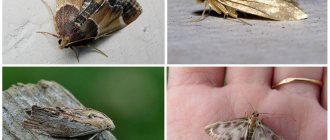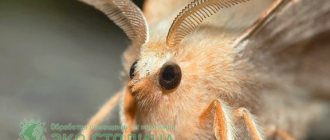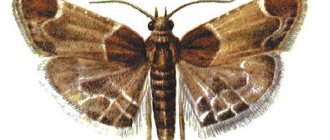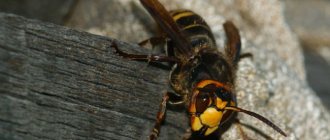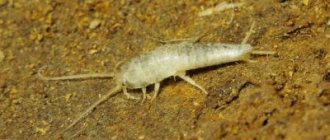Types of moth larvae
To figure out what a moth larva looks like, you need to find out what type it belongs to. Experts identify several types of these pests:
- Clothes - eats felt, wool, felt and other fabrics;
- Furniture – feeds on upholstery of upholstered furniture;
- Carpet - can greatly damage carpets, paths, rugs;
- Fur coat - prefers fur;
- Kitchen - found in grains (barley, rye or wheat), often spoils dried fruits, seeds, berries, nuts and seeds.
The main difference between these individuals is precisely their preferred habitat - the clothes moth larva will not settle in cereals, grain or flour, and the kitchen caterpillar will never gnaw through clothing or textiles.
In appearance, these larvae are almost identical - they are small white or yellowish caterpillars with a brown head and clearly visible gnawing jaws. Most moth larvae are worm-like and have 6 pairs of legs. Photos will help you verify this.
The larvae can also be recognized by the structure of their “house”. Thus, the caterpillars of fur coat, carpet and clothes moths make a small cocoon from the remains of damaged textiles and a silk-like substance and put it on themselves. In this form, they are even able to move short distances. As for the larvae of furniture and kitchen moths, they create tunnels from food scraps, silk and excrement.
Moths are an invisible but insidious enemy. In a very short time, your fur coat may become unwearable.
Having recognized the pupa by its appearance, you will be able to choose effective means to destroy these pests.
Features of food (grain) moths
The cream-colored worms that sometimes spoil flour, cereals, breadcrumbs, dry kvass, and oatmeal are the larvae of food or grain moths. Caterpillars eat grain, gnawing a tunnel in it. As a result, the product turns out to be completely spoiled - in addition to the larvae themselves, it contains excrement, eggs and their shells, as well as cocoons made from food waste, inside which the pupae sit.
At first, the eggs laid have a white shell, then they turn noticeably yellow. Newly hatched larvae are reddish in color, but become creamy as they mature. Their length rarely exceeds a centimeter.
If you look at a photo of a food pest larva taken with a magnifying device, you will see a whitish caterpillar with a smooth body, whose transverse segments and dark head are clearly visible. The legs that extend from the abdomen are underdeveloped in the larvae, but the gnawing apparatus is well developed, with the help of which the caterpillar bites into the hard body of cereals.
The eggs and larvae of the grain pest are afraid of temperature fluctuations.
- When heated above 60ºC, the egg clutch dies within 5 minutes, the larvae themselves die after an hour or an hour and a half.
- Freezing moth-infested products is slower compared to heating - when the temperature drops to -10ºC, death occurs after 3 days.
Note! The discovery of cobwebs in the product indicates the presence of mature pupae, from which moths ready to fly will soon emerge, which will give a new twist to the problem of how to remove food moths and their larvae. Therefore, it’s time to start disinfecting products and premises from the pest.
Clothes room or room
Clothes or indoor moths are the most fierce enemy of beautiful and expensive things; their larvae damage and deteriorate your favorite sweaters, warm socks and mittens, cozy shawls, scarves, blankets and upholstered furniture. All those fabrics and things that contain wool, silk, down or fur are at risk of being damaged by a clothes pest.
The peculiarity of the clothes pest is the desire of the females to burrow deeper into the folds of the fabric and lay eggs there, and worms will subsequently emerge from it, leaving behind ugly holes everywhere.
The search for caterpillars swarming in things should be carried out immediately as soon as a red butterfly fluttering in the room is noticed - there is probably already a habitat or egg clutch somewhere.
A scattering of tiny, up to 0.5 mm long, milky-colored eggs should be looked for in the hidden folds of clothes put away for storage that have not been taken out of the closet for a long time - things that are regularly worn are not suitable as a breeding ground for moths. The indoor pest especially loves dampness, which is where it prefers to leave its eggs.
Having discovered a cluster of caterpillars on an item of clothing or household items, as well as the holes they have made, you can assess the extent of the damage and at the same time find out what a clothes moth larva looks like.
- The caterpillars of the clothing-eating moth are much more transparent than the grain moth, from the moment they emerge from the egg they are about 1 mm long and milky in color, but due to the translucent abdomen, its darkening contents can be easily seen.
- The body is smooth, with clearly distinguishable segments.
- The head is brownish, dark, equipped with powerful gnawing jaws and salivary glands, from the secretion of which the clothes moth larva builds a cocoon for itself.
- Before pupation, the larva grows to one and a half centimeters.
The clothes moth's cocoon is obtained from a secretion that instantly hardens in air, which is a silk thread. It is hard to the touch and resembles the shape of a tiny spindle. After maturation, the actively flying males emerge from its shell first, and later the females, who fly poorly and rarely.
This is interesting! Initially, clothes pest moths enter people's homes by flying from the street to a light source in the dark.
Tips to help get rid of the pest:
Features of the fur pest
The moth, whose caterpillar “specializes” in furs, cuts off the lint on fur coats, fur collars and hats, leaving extensive bald spots, which renders expensive items unusable. Fur-lined shoes and mittens, as well as vests and other items with fur elements, can also become victims of the voracious house moth larvae.
A characteristic feature of the larvae of the fur pest is the presence of a kind of “house”, reminiscent of a cover made of clipped fur fibers. The larva moves with it, hiding inside it if necessary.
Remember! Fur moth larvae are especially harmful - they shear fur non-stop, regardless of whether the fibers are used for food or not, so they should be identified and exterminated urgently!
The body of the house moth larva is whitish, naked, translucent, the legs are poorly developed. The head is brown-brown in color with an excellently developed gnawing mouth. And adult moths differ from other moths by the presence of dark dots on their wings.
Features of different types
At home, there are food and also fur (clothing) types. The first include groceries in their diet. For the latter, haberdashery is more preferable. People can see what a moth larva looks like in a photo on specialized portals or in the relevant literature. The photographs clearly show their distinctive features, as well as what the eggs look like.
food moth
In the photo, the larvae of food moths are presented in the form of a small white caterpillar. The head and 6 pairs of legs are clearly visible, which are distributed throughout the body. The case length is 18–20 mm. As for volume, it largely depends on taste preferences and development conditions. If moth eggs were concentrated in fatty foods, then the size would be appropriate. When consuming food that contains virtually no nutrients, the worm's body becomes thin.
You can find food moths in the following products:
- Flour products and flour.
- Nuts, seeds and dry fruits.
- Pasta.
- Foods that are rich in carbohydrates.
You can determine the presence of food or grain moths and their larvae by focusing on the following signs:
- Cobwebs in containers with flour or cereal.
- Cocoons or tunnels containing worms inside.
- Lumps.
- Skins that remain after molting.
Worms can be found in places where there are nutritional components and an acceptable temperature. They are present not only in apartments, but also in warehouses, shops, and various enterprises. Adult pests lay eggs in secluded places.
Clothes moth
It is easy to determine the presence of clothes moths in an apartment. She gets out in the dark. You can find its larvae where there are materials and objects saturated with keratin. Main sources of nutrients:
- Fur and wool products.
- Carpets and palaces.
- Felt.
- Down and edges made of natural pile.
Clothes insects have other names:
- Fur coat.
- Furniture.
- Carpet.
- Woolen.
Indirect signs of the presence of body worms:
- Partial lack of lint.
- Holes in items of clothing, which should not be allowed.
- Moves focused on furniture upholstery or carpet products.
Some worms also attack shoes if there are no other food sources.
Stages of development of moth larvae
The pupa goes through 4 stages of moth development (or 4 molts). The timing of each stage is individual for each species and largely depends on living conditions. The ideal temperature for the development of caterpillars is +23-25 degrees. In this case, the development of the larva lasts up to 90 days, and the total cycle from egg to egg is about 6 months. When the air temperature rises to +30 degrees, this period is reduced to 60 days; when the air temperature drops to +13 degrees, it increases to 190 days. If the room is too cold (below +13 degrees) or too hot (above +30 degrees), the pupae will simply die.
Interestingly, food moth larvae develop much faster than other species. The higher nutritional value of food helps them in this. Coming out of the cocoon, the butterfly goes in search of a sexual partner. The male dies after mating, the female - after laying offspring.
Interesting! An adult moth does not have a mouthpart, so it cannot harm clothing. Having turned into a butterfly, this insect stops feeding altogether - nature deprives it of such an opportunity! The main danger of butterflies is their ability to lay eggs, from which offspring appear very quickly. Each new doll means a couple of new bald spots in a hat, sweater and fur coat.
The caterpillars of this domestic insect are characterized by low mobility - they rarely move long distances. Taking care of her offspring, the female lays eggs (from 30 to 200 pieces) either directly on the food or close to it. Literally after 5-10 days, microscopic larvae appear from them.
Reproduction and life stages of house moths
You can destroy moths in the house by interrupting the chain of life cycle of lepidopteran pests at any stage. While their eggs are almost impossible to detect due to their small size, the larvae or moth nest with a pupa are quite visible to the naked eye. In any case, to successfully fight, you need to understand how the moth reproduces and at what speed.
Caterpillars, or larvae, are the feeding life stage of these insects. Sloppy holes in a woolen dress, bald patches in a fur coat and tunnels in dried fruits are their business. And their oral apparatus is very powerful, because during its actively gnawing life the larva must store enough nutrients to pupate, develop into an adult butterfly and continue the race. A fertilized moth searches for a suitable food substrate, the larvae of which are inactive and spend their entire lives in it.
Clothes and food moths in an apartment where humidity and air temperature suit them can multiply at any time, giving up to six generations of the pest per year.
The average lifespan of one individual is 5–10 weeks, depending on the species. During this time, a caterpillar larva manages to hatch from the egg, thoroughly damage the wardrobe or food supplies, wrap itself in a cocoon, mature and hatch into a flying butterfly.
After fertilization and laying eggs, the butterfly dies, since its life mission ends and its strength is exhausted. By the way, the “applause” of irritated owners is usually received by male moths, because the underdeveloped wings of females are unsuitable for flight.
Some differences in the appearance and development cycle of food and clothes moths are presented in the table.
What do moth pupae eat?
Moth caterpillars eat a wide variety of things and foods. If in nature they eat bird feathers, animal hair, nuts, vegetables, grains, berries and fruits, then in an apartment their menu becomes much richer. This list includes furs, fabrics made from cotton, silk, flax, wool, as well as human hair. The main thing is that the materials are natural and old - they are easier to chew and digest. Parasites are especially attracted to clothes soaked in sweat and carpets with liquid spilled on them. In such places, the larvae receive not only food, but also water.
Among the food products moth pupae prefer:
- Muke;
- Bran;
- Mahnke;
- Krupam;
- Liver;
- Nuts;
- Seeds;
- Dried fruits;
- Tea;
- Candy;
- Pasta.
Of course, the caterpillar's stomach is not capable of accepting large amounts of food. She eats very little, so small damage can go unnoticed for a long time. The problem is that there are a huge number of pupae in the brood. After such a feast, things or food will simply have to be thrown away.
Where to look for moth larvae?
House moths avoid brightly lit places. Only some females pupate in the open. The permanent place of residence of these pests depends entirely on the species. So, clothes moths should be looked for in the clothes closet, and kitchen moths should be looked for in cabinets where food supplies are stored.
If you see a gray butterfly in your apartment, you can be sure that its larvae have already begun to damage things and food supplies. There are also a number of signs indicating the presence of pests.
Kitchen moth:
- Banks and bags of food are covered with a thin cobweb;
- Tunnels appear in sweets, in which larval secretions can be seen;
- Inside the cabinets and on the ceiling (in the corners) there are cocoons with pupae hanging;
- There are traces of molting;
- Spoiled grains are increasingly found in cereals;
- In the flour you can find stuck together lumps with worms inside.
Contaminated foods should not be eaten as chitinous shells, excrement or dead larvae may remain in them. After eating such a mix, you risk getting poisoned or getting an allergy.
Clothes, fur and furniture moths:
- Bald patches appear on carpets;
- In the cabinets there are cocoons with caterpillars;
- Large pellets are visible on furniture upholstery and clothing, with larvae hidden inside;
- Through holes appear on things;
- The fur near the base appears to have been trimmed with scissors.
Varieties of moths
Several types of moths can live in a person's home. Each of them is adapted to life in certain conditions. Many people are interested in what a house moth larva is? Not everyone knows what the pest looks like. Here everything largely depends on the type of pest. You can find masonry in a closet with clothes, inside a hat, in furniture upholstery, in bags of cereal or flour.
The main types of moths today include:
- fur coat;
- woolen;
- grain;
- furniture;
- rye;
- cabbage
The last variety is considered the largest. House moths are smaller. The color of the wings also depends on the species. The fur moth and wool moth have light wings and have a yellowish tint. The grain is darker. Her wings are brownish-gray.
Methods for destroying moth larvae
How to deal with moth larvae? This is a rather complex process that requires care and strict adherence to all instructions. It goes through several stages.
Step 1: Remove all clothes and bedding from your closets and check them thoroughly. Don't be lazy to shake everything up! The fact is that moth caterpillars do not adhere well to the surface, so if actively shaken, they will fall to the floor. It is better to throw away hopelessly damaged and very old clothes so as not to provoke pests to new attacks.
Step 2. Take the infected items out into the sun and warm them thoroughly. The main condition is that the air temperature outside must exceed +30 degrees.
To save things from moth larvae, just take them outside in the summer and thoroughly “fry” them in the sun.
Step 3. If the moth infestation occurs during the winter, place the clothes in the washing machine and wash them on the highest setting (above 50 degrees). Hot water helps destroy the eggs and larvae of not only moths, but also other parasites. The washing cycle should be at least half an hour.
Step 4. Try freezing what cannot be washed. Pack your items in a clean bag and place it in the freezer or outside for 24 hours. True, after freezing the clothes will still have to be at least rinsed.
Step 5: Clean the infected areas. First, the cabinets are vacuumed and then wiped with a damp cloth soaked in hot water with the addition of cleaning gel. Pay special attention to distant dark corners.
Step 6. To be safe, spray all surfaces with a disinfectant solution, insecticidal aerosol (Antimol, Armol, Raptor) or spray (Supromit, Suprozol, Neofos sprays). Treat clothes, carpets and furniture upholstery with the same products.
Step 7. Pack the items cleared of larvae into plastic bags. Special vacuum packaging is best suited for these purposes. If any individual survives the purge, it will not be able to survive without access to food.
Step 8. Place moth prevention products in your closet. This may be the old, proven naphthalene or newer preparations in the form of sections, fumigators and tablets (“Antimol” or “Prayer”). They are impregnated with an insecticide, which, when evaporated, creates unfavorable conditions for the development of larvae and the life activity of adults. An alternative to them will be special balls made from cedar wood. They contain essential oil that kills small moth pupae. They are no longer effective against large caterpillars. If desired, you can use bouquets of dried lavender or any ether that has a strong aroma.
Life cycle
Before turning into an adult, the caterpillar goes through several stages of development. The duration of each of them depends on certain indicators. Among them the following stand out:
- type of larva;
- temperature indicators;
- amount of food available;
- presence of relatives.
The duration of the development period can be from 1 to 3 months.
As soon as the larvae are born, they immediately begin to feed on the food available to them. Despite their small size, they eat often and a lot. When there is a lack of food, the caterpillars go on a “journey” through a piece of furniture or wardrobe in search of a more favorable place.
In the second and third months of life, the future moth looks for a dark place inaccessible to humans. There she moves to the next stage of development and turns into a pupa. Its size can reach 10 mm in length. The larva is reliably protected by a hard chitinous layer that covers the entire surface of the pupa. In it, it gradually develops and turns into an adult butterfly. When it reaches a certain stage, it gnaws through the shell with its jaws and comes out. This period lasts approximately 1-2 weeks. This indicator may vary depending on ambient temperature conditions.
The life cycle of a moth is short
The lifespan of a butterfly is only 20 days. During this short period, she must find a partner and mate with him. Then the female looks for a suitable place and lays several dozen eggs. They are very small and rarely larger than 1 mm in diameter. If the adult has done everything correctly, then after 7 days new larvae will be born.
A few hours after laying eggs, the moth dies. The male lives even shorter, ending his life cycle immediately after mating.
For moth caterpillars, the optimal conditions are +23…25°C. When this indicator decreases by several units, the entire development process slows down, and when it increases, it accelerates. If the temperature drops below +13°C or strongly increases (more than +30°C), the caterpillars or pupae die.
How to protect fur from moths?
To preserve your fur treasure for many years, listen to the advice of experienced moth fighters.
Tip 1. At the end of the winter season, your fur coat should be thoroughly cleaned with a clothes brush.
Tip 2. It is recommended to store fur products in special tightly closing cases. As a rule, they come complete with high-quality and expensive fur coats.
Tip 3. Wrap the hats in clean newspaper and place them in a box with a tight lid.
Tip 4. At least once a month, take your fur coat outside or onto the balcony and keep it there all day - moths do not like bright light and will rush to find more favorable living conditions. As for the larvae, they will die immediately.
Tip 5. This pest does not tolerate sudden changes in temperature and hates the cold. There are special refrigeration units for storing fur coats. If possible, buy yourself one.
Tip 6. From time to time, open the closets in which winter clothes are stored for ventilation. This should be done at least once a month.
Tip 7. Place a moth repellent next to your fur item and change it every 3-6 months. Such devices have an unpleasant odor, but reliably destroy the larvae. After using them, clothes must be well ventilated.
Tip 8. Fragrant soap will also help save your fur coat from moth larvae. Take it out of the packaging and put it in your pockets - its strong smell will repel any insects. Tobacco leaves, citrus peels and geranium branches have a similar property. They will have to be changed more often, because these products quickly erode.
How to fight: effective methods
The appearance of flying pests in an apartment is a reason to change some habits. For example, you should not leave cans of cereal open or put off washing T-shirts that smell of sweat.
How to remove moths from an apartment? Home remedies are suitable for repelling lepidopteran butterflies, but it is possible to destroy hatched larvae that harm things and furniture fabric only with the help of synthetic preparations. Timely treatment with chemicals allows you to quickly get rid of pests. Cereals and other bulk products should not come into contact with toxic drugs.
READ ALSO: The most effective moth repellents for killing and repelling harmful insects
There is one condition for successfully combating parasitic insects - to find all habitats, otherwise a new generation of moths will hatch from the remaining three to five eggs.
What to do:
- inspect the seams on clothes, especially carefully, those made from natural fabrics;
- check all jars of cereals, bags and sacks of flour, containers with dried fruits, bran, pasta, and other bulk products;
- carefully inspect fur hats and fur coats, especially in the areas where parts are connected;
- take out all the things from the closets, shake each one over the bathtub. If larvae are detected, collect parasites, soak and wash clothes, then fry in the sun or freeze sweaters, knitted dresses, scarves;
- check the joints of upholstered furniture, the back of sofa cushions, and the bedding storage box under the bed. Attach a disposable dust bag and carefully collect all adults and larvae. If you vacuum all parts of the sofa, the risk of “forgetting” pests in a secluded corner is significantly reduced;
- Clean all fur products, collect parasites if lepidopteran butterfly larvae are identified. There is a lot of horny substance in the base, it is no coincidence that moths often appear in fur items. If the hat is hopelessly damaged or fur is coming out of the fur coat in shreds in different areas, then it is advisable to dispose of the heavily damaged item, regardless of the cost of the product. If at least one or two eggs remain, from which larvae emerge, the process will begin again, the pest population will reach alarming proportions within the apartment;
- If fur items are slightly affected by fur moth larvae, then you need to thoroughly clean all problem areas, treat them with insecticides, hang the item in the sun, and “fry” it to destroy pests. On a frosty day, you can keep hats and fur coats on the balcony for two to three days so that the parasites die;
- look into the kitchen cabinets, put things in order, collect spilled flour, cereals, oatmeal, and pasta from the shelves. It is important to choose containers for storing bulk products with a tight lid. The best option is glass containers or food-safe plastic containers. To repel pests, place a couple of bay leaves or 2-3 cloves of garlic in each container.
Chemicals
To combat larvae and adult insects, the following moth repellents are used in the apartment:
- Armol.
- Difox.
- Raptor.
- Tornado.
- Clean house.
- Dichlorvos Neo is odorless.
Modern drugs quickly kill moth larvae, but have a toxic effect. If you have allergies, chronic diseases, or if children or an expectant mother live in the apartment, you will have to refrain from using potent compounds.
READ ALSO: Grain or food moth: how to get rid of larvae and adults and eliminate the source of infection
After treating the infected areas, it should take several hours for the smell of insecticides to dissipate. Disinsection must be carried out in compliance with safety rules, protecting the face, respiratory tract, eyes, and hands from contact with pesticides. The effect of modern insecticides often lasts 3–6 months.
Folk remedies
Safe natural products and plants are suitable for repelling lepidopteran butterflies:
- cloves;
- fir, lavender, mint, eucalyptus essential oil;
- tobacco leaves;
- pine toilet soap;
- sprigs of pine, spruce or cedar;
- dry peels from tangerines or oranges;
- geranium leaves and flowers;
- dried wormwood;
- Bay leaf;
- bouquet of dried lavender flowers.
How to properly store a mink coat in the summer at home? We have the answer!
Read about how to hang a horseshoe over the door to attract prosperity and prosperity at this address.
On the page, learn about the rules and features of caring for ampelous geraniums at home.
Other pest control methods:
- boiling clothes, ironing with a hot iron;
- freezing knitted wardrobe items;
- airing fur coats, hats, wool and wool mixtures on the balcony in hot, sunny weather;
- regular cleaning of carpets, use of a vacuum cleaner when caring for upholstered furniture;
- proper storage of fur and knitted products, bulk products, dried fruits, nuts.
How to remove kitchen moths?
The larvae of house moths that live in the kitchen are hatched differently. Everything is much more complicated here!
How to destroy kitchen moths in an apartment, read more in this article.
- Empty kitchen cabinets;
- Vacuum them thoroughly using special narrow nozzles - they will allow you to reach hard-to-reach places;
- Clean the “insides” of the cabinets with a brush, dipping it in hot water with added detergent;
- Spray the shelves with a vinegar solution and wipe off the liquid with a sponge. This will destroy caterpillars and moth eggs. Vinegar can be replaced with liquid bleach. Dilute it with water 1:4, pour into a container with a spray bottle and use for spraying. Bleach contains chlorine, so be very careful not to get it in your eyes, nose or mouth. Its contact with places where food is stored can also be dangerous. After treatment, thoroughly wash the furniture with clean water and make sure that no traces remain on its surface;
- Conduct an audit of food supplies. The bag in which the moth began to breed must be tightly tied and carefully taken out into the trash. It is also better to throw away contaminated products - they can become a source of repeated troubles. Unopened packages can be safely left behind;
- Have you noticed any moth larvae and have no intention of getting rid of your supplies? Fry them in the oven at 60 degrees or put them in the microwave for 5-7 minutes. If heat treatment is not possible, freeze within a week;
- Wash food containers in the dishwasher or very hot soapy water. Then they need to be rinsed with vinegar.
Be very careful - an undetected pupa or a butterfly left alive can reinfect your apartment. Also remember not to use chemical insecticides in the kitchen.
You need to know this: 5 tips on how to get rid of food moths in the kitchen at home!
How to get rid of moths and their larvae
The appearance of moths in an apartment indicates that the housewife forgot about the existence of such pests and did not take measures to prevent their appearance. Moths can enter a home in various ways, but this does not mean that they will begin to actively reproduce. To do this, she needs special conditions: appropriate temperature and access to food, as well as the absence of any obstacles in her way.
The most common mistakes of housewives:
- The housewife keeps unwashed clothes in the closets, which attracts moths.
- Improper storage of fur products: housewives think that they will be safer in plastic bags.
- The practice of storing large quantities of food, not for days, but for months. As a result, food spoils due to the appearance of food moths.
- Infrequent cleaning of closets, so things are not ventilated and are not moved from place to place.
- Particular attention should be paid to knitted items, which is not done.
- Lack of desire to take at least minimal preventive measures to prevent moths from appearing in the apartment.
Wool moths are the most resilient and can withstand sudden temperature changes. It is most difficult to deal with if it has wound up among warm things. As a rule, after damage, even the slightest, a warm item can no longer be worn. If after any measures there are only a few eggs left, you need to wait for a new population. To prevent this from happening, you need to very carefully destroy the moth, no matter what method is used for this.
How to get rid of moths - Everything will be fine - Issue 534 - 01/20/15 - Everything will be fine
Application of chemicals
Synthetic preparations are most effective in conditions of large accumulations of eggs and larvae. As a rule, things are damaged not by adults, but by their larvae, and this must be remembered. It is also necessary to remember that it is also impossible to treat food products with chemicals. If moths have spoiled food, you will have to throw it away. Experts do not recommend eating such foods. Cleaning the kitchen involves treating all surfaces with a soap-soda solution, which has good disinfectant properties.
Sprays and aerosols that can be used to combat moths:
- Clean house.
- Armol.
- ARGUS.
- Raptor.
- Dichlorvos Neo.
- Mosquitall.
- Difox.
- Zkstra Mit.
- Tornado.
On a note! The use of such substances requires the use of personal protective equipment, which is necessarily mentioned in the instructions. These are toxic drugs with a pungent odor. Some more modern products do not have this smell. Even if the product has a smell, it will disappear in a couple of days if everything is done correctly. Some drugs continue to work for up to six months.
Folk methods of struggle
Before the advent of chemical components, exclusively folk methods and means were used in the fight against moths. Although they do not act as quickly as chemicals, they are no worse in effectiveness, under certain conditions. The manufacture of folk remedies does not require expensive components. The advantage of traditional methods is that they are safe for humans and pets. Therefore, many housewives prefer this type of fight against moths.
Popular folk remedies include:
- orange and tangerine peels;
- dry tobacco leaves;
- essential oils of mint, geranium, eucalyptus, lavender;
- lavender inflorescences, wormwood leaves;
- cedar bark and other coniferous trees;
- geranium flowers and leaves;
- toilet soap with pine scent.
Natural, persistent aromas negatively affect adult individuals, preventing them from reproducing in such conditions. Without adult flying individuals, clutches of eggs and then larvae, which are particularly voracious, will not appear.
It should also be noted that there are absolutely free moth repellents, such as:
- frying in direct sunlight;
- freezing at low temperatures;
- treating things with hot water, with a temperature not lower than 60-70 degrees.
how to get rid of moths using folk remedies
Preventing moths
The best way to prevent moths from entering a room and its further reproduction is to carefully check the products purchased and regularly wash things. Other methods of combating these universal pests, capable of living on very meager rations, have not yet been found. Also take note of a couple of useful points:
- Do not buy products for more than 7 days;
- Store food in tightly sealed containers;
- Subject purchased flour and cereals to mandatory heat treatment;
- Place fine-mesh mesh on the ventilation ducts;
- Shake purchased clothes well outside and wash them.
Prevention
House moth larvae often appear even in fairly attentive housewives. What should you do to never encounter this unpleasant problem? Try to ventilate your apartment as often as possible. Items should be stored for storage only after they have been washed and ironed. If possible, try to expose fur and knitted items to the sun or frost at least once a year. Under no circumstances should you store knitted scarves, suits and sweaters in bags. It is better to treat valuable furs with special compounds that prevent the appearance of moth larvae. You can place sachets of tansy, wormwood or lavender in your closet.
A simple and fairly convenient method is to use dry orange peels. Antimol tablets also give a good effect. You can also put small pieces of cloth soaked in essential oils of mint, eucalyptus or tea tree in your closet. Such strong odors will repel insects. To prevent the appearance of food moths, try to sort out the cereal regularly. Also, do not buy a large supply of flour and cereals in advance. When choosing a product, check its quality. Infestation by food moths can be indicated by glued particles and lumps inside the package. Try to keep your apartment tidy. Regularly wipe down your kitchen cabinet shelves and prevent dust from building up.

